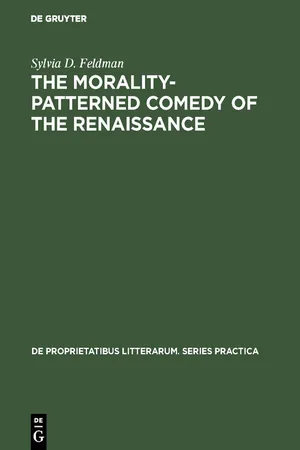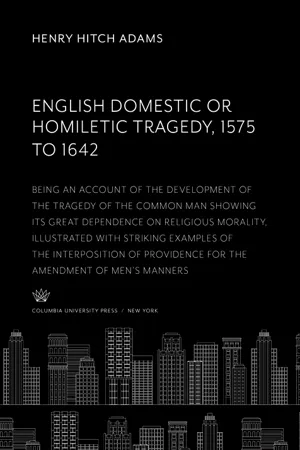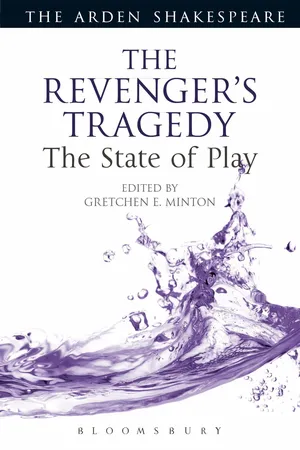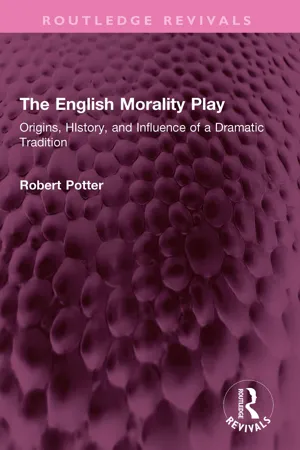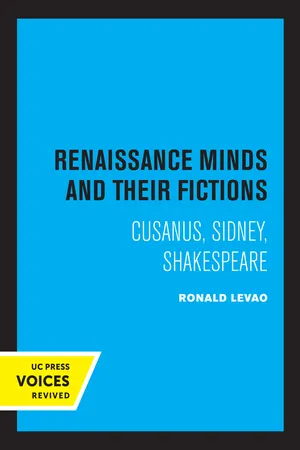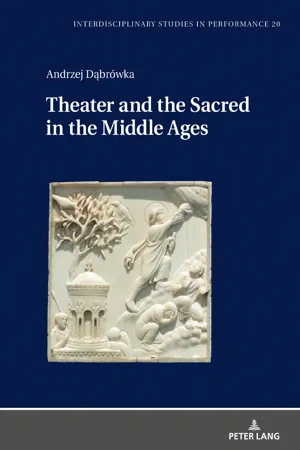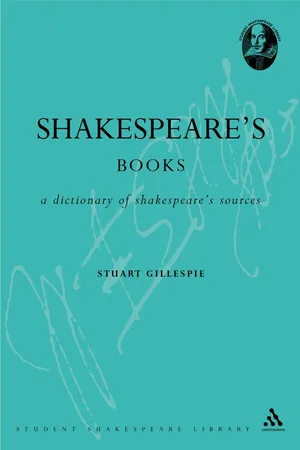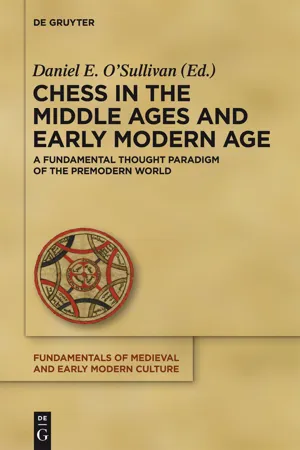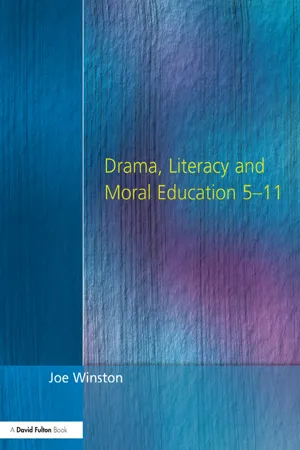Literature
Morality Plays
Morality plays are a genre of medieval and early Tudor theatrical productions that aimed to teach moral lessons through allegorical characters and situations. These plays often depicted the struggle between good and evil and emphasized the consequences of one's actions. They were popular in Europe during the 15th and 16th centuries and served as a form of moral instruction for the audience.
Written by Perlego with AI-assistance
Related key terms
1 of 5
9 Key excerpts on "Morality Plays"
- Sylvia D. Feldman(Author)
- 2018(Publication Date)
- De Gruyter Mouton(Publisher)
In his 1914 study of the English morality, Roy Mackenzie described it as drama which is . . .allegorical in structure. 2 And in his 1914 study of English drama, Felix Schelling reached the conclusion that ...allegory is the distinguishing mark of the moral plays. 3 This emphasis has not changed in the last fifty years. In his excellent 1961 Guide to English Literature of the Middle Ages, David M. Zesmer, for example, defines the morality play for the student as . . .a dramatized allegory, best exemplified in Digby Mary Magdalene. I have done so because of the necessity of estab-lishing limits to this study and because I feel that the four plays included here are adequate for the purposes of establishing the morality features. 2 Roy W. Mackenzie, The English Moralities from the Point of View of Allegory (Boston and London, Ginn and Company, 1914), p. 9. 3 Felix E. Schelling, English Drama (London, J. M. Dent & Sons, Ltd., 1914), p. 24. 42 THE MORALITY PATTERN, A DEFINITION Everyman . 4 And in his 1962 study of the relationship between the morality play and the structure of Renaissance drama, David Bevington echoes what was said half a century before; he states that the morality .. .was characterized primarily by the use of allegory to convey a moral lesson about religious or civil conduct. 5 Yet after the morality has been defined largely on the basis of allegory, we know relatively little about it. As Hardin Craig has said: It is true that a morality play is a dramatized allegory and that no drama is a morality play unless it has this characteristic feature, but even this statement leaves the subject vague.- eBook - PDF
English Domestic Or, Homiletic Tragedy 1575 to 1642
Being an Account of the Development of the Tragedy of the Common Man Showing Its Great Dependence on Religious Morality, Illustrated With Striking Examples of the Interposition of Providence for the Amendment of Men'S Manners
- Henry Hitch Adams(Author)
- 2019(Publication Date)
- Columbia University Press(Publisher)
Chapter Four Morality Plays W H I L E on the Continent humanistic ideals prevented free development of popular drama, in England the theatres remained for the most part in the hands of the people. The first English dramas to emerge from the church were the mysteries played on pageant wagons before audiences of townspeople in Coven-try, York, and other large towns. The Morality Plays continued and developed the tradition of serious entertainment for the general pop-ulace. Through the media of allegorical and generalized characters these dramas taught moral lessons. Everyman was rich, but he was still every man, king or beggar. Gradually the abstract vices and vir-tues assumed the characteristics of men and women of the middle class. Even the figures of kings and nobles appeared as seen through bourgeois eyes. The early moral dramatists had no appreciation of the difference between tragedy and comedy and took no pains to develop sympathy for their leading characters. The protagonist of a moral play was chosen to exhibit specific vices which were punishable by death and damnation unless the force of mercy intervened. In the earliest of these plays, the author made little effort to show whether a sinner was really worthy of mercy. Gradually, however, the customary steps of repentance and penance necessary for the salvation of the soul became important parts of the plays. All through the Tudor and early Stuart periods, the idea of mercy continued to appear in the Morality Plays and in their descendants, the domestic tragedies. The belief in an easily obtained mercy prevented the development of a real tragic spirit. Pro-fessor Farnham remarks: So long as the moral dramatist and his au-dience conceive that a universal law of justice, under which a man lives and engages himself with his destiny, is dominated by the force of mercy, their recognition of tragedy must necessarily be small. 1 1 Willard Farnham, The Medieval Heritage of Elizabethan Tragedy, p. 193. - eBook - PDF
- Gretchen E. Minton(Author)
- 2017(Publication Date)
- The Arden Shakespeare(Publisher)
By the first decades of Elizabeth’s reign, many Morality Plays were not obviously Christian or even moral; to call The Revenger’s Tragedy a morality play, therefore, puts it in like company. King estimates ‘seventy or so surviving interludes written between the period of the medieval saints’ plays, scriptural plays, and Morality Plays and the construction of the first Elizabethan theatres’ have much in common with medieval Morality Plays. 19 Plays ranging from John Skelton’s Magnificence, usually dated between 1520 and 1522, to Nathaniel Woodes’s Conflict of Conscience, likely composed shortly before 1581, rely on allegorical characters and feature conflicts between virtue and vice characters to represent the struggle for an individual’s soul. Some later plays make only minor changes to the conventions found in medieval drama. For example, John Bale adapted the morality play to disseminate Protestant doctrine in plays like Three Laws (1538) by staging vices in the guise of hypocritical Catholic clerics. Some of these Morality Plays were performed at court, but a significant number appeared in school and university settings for educational as well as entertainment purposes, and quite a few have been associated with public performances by travelling companies. As one would expect of any long-lived theatrical tradition, Morality Plays did not remain static across decades. Earlier Morality Plays often focus around a central humanus genus character who stands in for all people. (That said, even the plays with titles linked with this trope seem less universal when analysed carefully – Everyman is a particular type of man, a VINDICE AND THE VICE OF REVENGE 25 merchant, and Mankind is a farmer.) More individualized central characters receive attention in later plays. - eBook - ePub
The English Morality Play
Origins, HIstory, and Influence of a Dramatic Tradition
- Robert A Potter(Author)
- 2023(Publication Date)
- Routledge(Publisher)
Chapter V Early Elizabethan plays in the morality traditionThe traditional morality play had both an immediate and a delayed influence on the Elizabethan drama. In the ultimate sense it provided the inherited mythic idea of a theatrical treatise on the human condition – a fabric of dramatic assumptions out of which great plays of the order of Dr Faustus, Henry IV, Part One, Measure for Measure, Othello, Volpone, and King Lear could be created. In the direct sense, however, the morality play appeared to the Elizabethans as a set of traditional stage conventions of plot and character that could be put to many useful and contemporary theatrical purposes in the emerging popular drama. The nearly thirty years that separate Elizabeth’s accession from the staging of Marlowe’s Tamburlaine constitute a formative and confusing period of change in English drama, and an examination of the existing corpus of plays from that period shows how central the morality tradition is to the process of change. Of the sixty-one extant English plays from the period 1558–86, some twenty-eight can be plausibly connected with the morality tradition and they are of many sorts: moral interludes, tragedies, ‘youth’ plays, academic allegories, satiric comedies, neoclassical legends, Biblical plays, histories, and romances:1In this profusion of experiments three early Elizabethan dramatic inventions based on the morality emerge as of particular interest and importance. They are the nascent traditions of moral comedy, the political history play, and homiletic tragedy.1 Moral comedy
The numerous printed texts of Elizabethan moral interludes from the 1560s and 1570s document the emergence of a didactic and ethical drama, concerned with problems of everyday human behavior and earthly justice rather than ultimate questions of salvation. Recent critics such as Alan Dessen, Edgar Schell, and J. D. Shuchter have reconstructed a theatrical context for this ‘transitional and experimental drama,’2 - eBook - PDF
Renaissance Minds and Their Fictions
Cusanus, Sidney, Shakespeare
- Ronald Levao(Author)
- 2023(Publication Date)
- University of California Press(Publisher)
For even as these nonearnest, projected worlds determinedly 259 2Ó0 William Shakespeare point beyond themselves to higher truth, they inevitably re- lease the less manageable forces of the imagination. Evidence of instability ranges from local abuses to more deeply seated anxieties. Monstrously masked priests gesturing and singing obscenely in the church, uneasiness about representations of evil in religious plays, and more general discomfort about hu- man feigning as an abomination to God's truth, all indicate a potential for trouble. 5 N o form of religious drama magnifies that potential more than the Morality Plays of the fifteenth and sixteenth centuries. Like its predecessors, the morality play pictures man's relation to the eternal; Everyman is one extant masterpiece that takes to heart its own advice to the audience: "in the begynnynge / Loke well, and take good heed to the endynge" (lines i o - i i). But other moralities engage a theatri- cal self-enjoyment less willing to accept Everyman's stringent logic of self-denial, in which the time has passed for "sporte and playe" (line 201). Because of the shift in focus from liturgy and the pageant of sacred history to an allegorical analysis of the individual mind, the morality openly represents—in its mischievous Vices—the mercurial inventiveness of play mak- ing itself. Mental events that ought to be suppressed are dra- matically exciting. Mankind (ca. 1470) notoriously exploits its audience's desires by halting the action and extorting fees be- fore allowing its chief devil to take the stage and its fullest horseplay to unfold, including a visit to the Court of Mischief, where the language of authority degenerates into parodic gib- berish. Evil, theologians comfortingly tell us, is the absence of being and is therefore merely ludicrous; evil figures on the stage are to be ridiculed and rejected.' But morality Vices have an undeniable stage presence. - eBook - PDF
- Andrzej Dabrówka(Author)
- 2019(Publication Date)
Cf. “pedagogical stories” (ch. 24.3; Carruthers 1998). The Morality Play 434 old identity, disrupted by the pact with the Devil. The protagonist of Morality Plays “seeks the final goal,” which makes each episode a step: to reach this goal means to resolve a conflict, thus discontinues action; unlike in farce, in which an ending enables the next joke (A. E. Knight 1983: 51). However, the resolu- tion of the conflict in miracle plays is no less definitive than in Morality Plays, although the subject finds or achieves no goal without the intervention of a higher power. In turn, farce often is an anecdotal episode that offers no possible continuation. 4. SELF-CONTROL happens at this stage of the transcendentalization of the sacred already without divine intervention. People were shown the way to the truth or maybe only the goal and the compass, while we had to choose the path on our own? The morality play explicates the norm (A. E. Knight 1983: 64), which means that the function of this genre is constantly to remind of the stan- dard and demonstrate the pattern, not to “distort” the image of God. The context of recapitulation requires that we recall the collective dimension of this task. According to The Castle of Perseverance, the source and guarantor of community norms is liturgy, while Lucifer threatens its standards (Cox 1996: 194). The two dimensions resemble the division of genres. In personal Morality Plays, subjects are responsible for their salvation, which they achieve through sacramental life, not through a miracle. When following a path through the forest full of temptations and dangers, we want to believe that our trip is well- planned. Pilgrimage, a well-known form of folk devotion (ch. 5.4), is a frequent motif in Morality Plays. Pilgrimage serves as visual representation of the internal struggle, which allows its participants to objectify the inner fight and observe it from the outside. - eBook - PDF
Shakespeare's Books
A Dictionary of Shakespeare Sources
- Stuart Gillespie(Author)
- 2004(Publication Date)
- Continuum(Publisher)
In such a play as Lear there are, of course, many stubbornly realistic and literal features which are irreducible to what is traditionally thought of as morality play modality: ‘the bare outlines of the dramatic type have been overlaid and often obscured by the fullness of the plot and the intricacies of the relationship between the characters. The personi fi cations of the medieaval play have grown into human beings as complicated and unpredictable as men and women usually are’ (Campbell 1948: 108). On the other hand, morality play modality is not necessarily simple and uniform, since moralities themselves sometimes mix ‘imitative forms and functions . . . with transmuted ritual’ (Weimann 1978: 69), and there are a number of indubitable ‘personi fi cations’, and other non-representational elements, in Lear . The best-recognized is the ‘Pity in the Stocks’ emblem with Kent in 2.2 (see Riebanz 1962, and for other morality details Muir 1972: xxv–xxix). Herein lies a challenging area for criticism, in the region between the clearly non-morality overall effect and the morality elements and devices incorporated at a more local level. Lear ’s presentation of questions about identity, about evil and retribution, penance and despair, all invite the question not of how far we should read the text as a morality play, but of ‘how a morality play has been transformed into King Lear ’ (Potter 1975: 152; whose discussion goes on to offer one of the most convincing answers to the question to date). Finally, in relation to Shakespeare’s drama as a whole, there is a possibility of major structural in fl uences from the morality tradition. Baldwin (1947) attends to the rise of the fi ve-act structure in these dramatic predecessors of Shakespeare’s. Weimann (1978) considers the dramaturgy of space ( platea and locus ). More speci fi cally, basic morality structures may be discerned below a number of Shakespeare plays and parts of plays. - eBook - PDF
Chess in the Middle Ages and Early Modern Age
A Fundamental Thought Paradigm of the Premodern World
- Daniel E. O'Sullivan(Author)
- 2012(Publication Date)
- De Gruyter(Publisher)
6 Murray loosely defines the chess morality as a text “devoted. . . to the allegorical explanation of chess, generally on the broad line that the game was emblematic of the social condition of the time.” 7 Yet in his chapter on chess moralities, Murray seems to have interpreted the “social condition” in much broader terms since he includes texts with a religious and love theme as well. He includes certain works such as the Echecs amoureux in which the chess match allegorically represents the process by which the man falls in love with the woman, and others which use the allegory to describe man’s religious plight in the world. Furthermore, it is difficult to establish what precisely he understood to characterize this type of literature since Murray does not claim to be thorough in his treatment of chess moralities and the forms in which they appear are varied. Certain stand on their own and may be as brief as 48 verses, such as the Anglo-French poem in an Oxford manuscript (Ms. Corpus Christi College, 293, f. 142b) 8 4 Very little is known about the origin of the Jeu . I will offer some hypotheses in a future edition of the Jeu . while others are a part of a much larger narrative as in the case of the Echecs amoureux or the Songe du Vieil Pelerin . Should one give this 5 Murray, A History of Chess , 558 (see note 3). 6 Jenny Adams talks about certain works of the chess morality tradition in Power Play (see note 1) . She describes these works as “chess allegories.” Since the game of chess, however, is used in many genres of medieval literature as a simple allegorical image and must be differentiated from works in which the description of the chess game is intended to teach a moral lesson, I believe that Murray’s description of the works as “chess moralities” is more appropriate.. 7 Murray, A History of Chess , 529 (see note 3). 8 Östen Södergård, ed. “Petit poème allégorique sur les échecs,” Studia Neophilologica 23 (1950–51) 127–36. - eBook - ePub
- Joe Winston(Author)
- 2013(Publication Date)
- Routledge(Publisher)
Drama, being both social and active by nature and centred around stories, can contribute to both aspects of a primary school’s moral curriculum, those involved with the development of positive moral attitudes and behaviour – of care and responsibility, for example – and those that endeavour to introduce children into the conceptual language of moral thinking and develop their imaginative appreciation of the social needs of others. It can use stories to help develop certain moral values and attitudes, certainly; but it can also, very effectively, help children think, feel and ask questions about moral issues that are as complex as they are fundamental to being human. The rest of this chapter will attempt to explain and illustrate how drama can do this, with specific reference to examples drawn from the six drama projects described in the previous chapter. In it I will analyse those aspects of drama that make it well-placed to assist the moral education of children, beginning with the unique way in which stories are experienced through drama, through physical enactment.The moral power of enacted narrativeIn schools, most stories are either read or told; in either case, the medium is words. In drama, words are of course important but they are complemented by a variety of visual and aural signs. The people in the stories are visible and audible; we see how they look and how they act and hear what they say and how they say it. They might be wearing or holding something significant – a hat, an old jacket, a letter, a stick – or they might be sitting in silence as someone else speaks to them or about them or while other sounds can be heard – music, or voices off. These visual and aural signs carry meanings which are both literal and symbolic and which gain added power by operating in both fields of meaning at once.ObjectsIn a play, a letter on a table is more than just a communication. If the story is about marital betrayal it could be from a lover, signifying the infidelity of one of the partners or from a blackmailer, signifying their sense of guilt. In both cases we can see that the symbolic meanings carry with them a moral charge and, in good drama, this moral charge can be made all the more potent by the sensorial impact of our seeing the letter there and listening
Index pages curate the most relevant extracts from our library of academic textbooks. They’ve been created using an in-house natural language model (NLM), each adding context and meaning to key research topics.
